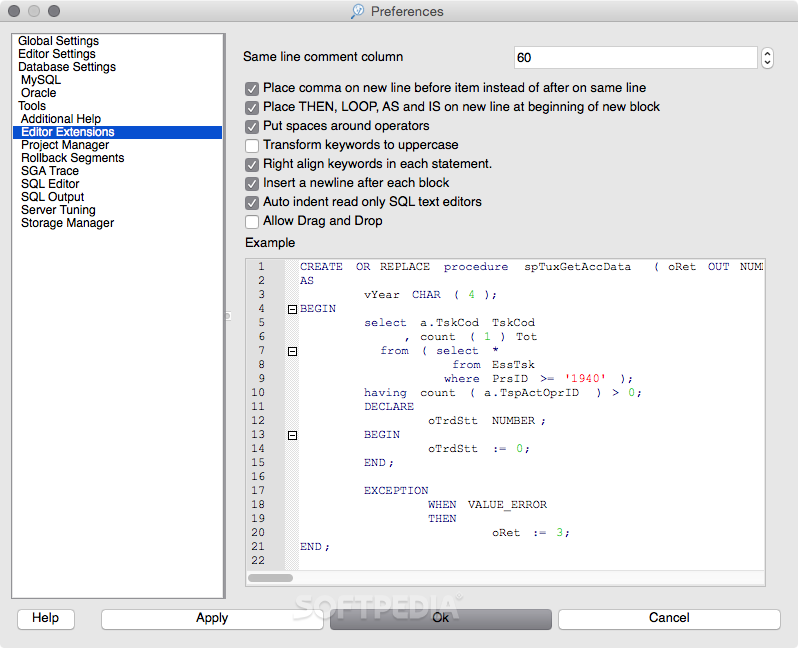This chapter describes how to build and run the SQL*Loader and PL/SQL demonstration programs available with Oracle Database. It contains the following sections:
Feb 12, 2016 With SQL Developer, you can browse database objects, run SQL statements and SQL scripts, edit and debug PL/SQL statements, manipulate and export data, and view and create reports. You may want to check out more Mac applications, such as Cornerstone, which might be similar to SQLDeveloper. (对于 64 位 Intel Macs,请下载 Java for Mac OS X 10.5 Update 1。 对于新版本的 Mac OS,请使用“软件更新”特性) - 在“下载”页面下载 OS X 文件。 - 双击 SQL Developer 图标.
Note:
To use the demonstrations described in this chapter, you must install the Oracle Database Examples included on the Oracle Database 10g Companion CD.You must also unlock the JONES account and set the password before creating the demonstrations.
7.1 SQL*Loader Demonstrations
Run the ulcase.sh file to run the SQL*Loader demonstrations. To run an individual demonstration, read the information contained in the file to determine how to run it.
7.2 PL/SQL Demonstrations
PL/SQL includes a number of demonstration programs. You must build database objects and load sample data before using these programs. To build the objects and load the sample data:

Change directory to the PL/SQL demonstrations directory:
Start SQL*Plus, and connect as JONES/
password:Run the following commands to build the objects and load the sample data:
Note:
Build the demonstrations as any Oracle user with sufficient privileges. Run the demonstrations as the same Oracle user.
PL/SQL Kernel Demonstrations
The following PL/SQL kernel demonstrations are available with the software:
examp1.sqltoexamp8.sqlexamp11.sqltoexamp14.sqlsample1.sqltosample4.sqlextproc.sql
To compile and run the exampn.sql or samplen.sql PL/SQL kernel demonstrations:
Start SQL*Plus, and connect as JONES/
password:Run a command similar to the following to run a demonstration, where
demo_nameis the name of the demonstration:

To run the extproc.sql demonstration:
If required, add an entry for external procedures to the
tnsnames.orafile, similar to the following:If required, add an entry for external procedures to the
listener.orafile, similar to the following:Note:
The value that you specify for SID_NAME in thelistener.orafile must match the value that you specify for SID in thetnsnames.orafile.On HP-UX, Linux, Solaris, and Tru64 UNIX:
On AIX:
On Mac OS X:
Change directory to
$ORACLE_HOME/plsql/demo.Run the following command to create the
extproc.soshared library, build the required database objects, and load the sample data:Note:
On Mac OS X systems, use the shared library nameextproc.dylibin the following examples.Alternatively, if you have already built the database objects and loaded the sample data, then run the following command:
From SQL*Plus, run the following commands:
To start the demonstration, run the following command:
Pl Sql For Loop
PL/SQL Precompiler Demonstrations
Note:
Themake commands shown in this section build the required database objects and load the sample data in the JONES schema.The following precompiler demonstrations are available:
examp9.pcexamp10.pcsample5.pcsample6.pc

Pl Sql Developer Mac Os
To build the PL/SQL precompiler demonstrations, set the library path environment variable to include the $ORACLE_HOME/lib directory, and run the following commands:
To build a single demonstration, run its name as the argument in the make command. For example, to build the examp9 demonstration, run the following command:
To start the examp9 demonstration, run the following command:
7.3 Calling 32-Bit External Procedures from PL/SQL
Note:
This section applies to AIX, HP-UX, Solaris SPARC, zSeries Linux, and Apple Mac OS X (Intel).The 64-bit external procedure executable (extproc) and the 32-bit external procedure executable (extproc32) are installed in the $ORACLE_HOME/bin directory. By default, the extproc executable is enabled to run 64-bit external procedures on AIX, HP-UX, Solaris SPARC, and zSeries Linux systems. To enable 32-bit external procedures:
Pl Sql Mac Os X
Set the value of the
PROGRAMparameter in thelistener.orafile as follows:Include the
$ORACLE_HOME/lib32directory in one of the following environment variables, depending on your platform:Platform Environment Variable AIX LIBPATHHP-UX SHLIB_PATHLinux on POWER, zSeries Linux, and Solaris LD_LIBRARY_PATHApple Mac OS X (Intel) DYLD_LIBRARY_PATHRestart the listener.
Note:
You can configure a listener to run either 32-bit or 64-bit external procedures, but not both at the same time. However, you can configure two listeners if you have to support both 32-bit and 64-bit external procedures.
